|

Honeybee explores the dimensions of allium plant.
(*photo credit)
August 1, 2014 Personal Growth: Rest Secure or Demand More?
When it comes to personal improvement, two approaches exist:
1. Good, better, best; never let it rest,
until the good is better and the better is best; or
2. It is the best I can do.
The first adage is the quest for excellence. "Tap all the native intelligence and opportunities you can muster." These champions desire to equal some objective goal or model, or they may be motivated by money, fame, or fortune. Let's be fair, for there could be greater goals than material ones; they could involve spiritual excellence and a praiseworthy desire for betterment and reaching godliness. When I first considered these two approaches to improvement, competition between people or to better another person stood out in the first adage -- and that's stressful. But what if the model was Theresa the Little Flower, who prayed that this quest for success continue even past mortal life to include an eternal quest to show greater love of God in works performed?
The first dictum has merit worth considering, depending on times in life. Perhaps an internal competition (not besting another but our own past) can be a good thing, especially for people who have a history of laziness, diffidence, or missing the mark. However, when working as hard as one can, this first type of improvement could prove stressful and even harm performance. Perhaps we move from one adage to another depending on our state of life. If so, it is not that one is superior, but where do I fit here and now on my journey in life? Improvement demands stamina, energy, time, and encouragement to reach a goal. Both admit that resources are limited, time short, and exercise exhausting, but with perseverance comes victory, provided we are not too judgmental when comparing success. Do we accept our present condition?
The second dictum refuses to accept so-called objective goals of success (score, race time, degree, measure of wealth, etc.). Such goals may be fit for others, but not for me. If another is excellent at one or other activity, more power to them. I prefer to compete with myself and not with them. Second dictum champions regard competition among people as frivolous and mere games of Godless capitalists. A greater goal is to be FIRST to take up an issue or task that others find too difficult to undertake. However, the internal improvement of this second approach has elements of the first at periods of time. It's consoling to do the Lord's work and to be thankful for improvement opportunities.
I never accepted others' evaluation of my work for I did my best. All through Theology School I never asked for or looked at grades, for if they were good, I would feel complacent and, if bad, I would have been needlessly disturbed. Just do my best and let it rest was the ongoing goal. It yielded no stress.
Prayer: Lord, I could have done better and others know it, but I trust in you to accept me for who I am and forgive my failures.
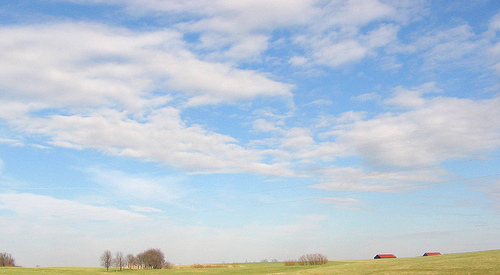
Clouds and sun over Bluegrass skies.
(*photo credit)
August 2, 2014 Observe Breastfeeding Week
Some observances do not apply to everyone unless we look at them in a broader social context. I cannot breastfeed but, while not recalling it, I was breastfed. And many of us advocate the practice among expectant and new mothers. Recent scientific research indicates the beneficial effects of breast-, in contrast to bottle-feeding. Commercial infant formula has immense markets and high-profit potential, even while breastfeeding is deliberately promoted by caregivers in poorer emerging nations where the formula can easily be harmful through mixing with contaminated water.
Apparently breastfeeding went out of favor in post-World War II America, when in the decades following the practice dropped to as low as one-quarter of all new-borns being breastfed. By the 1960s, the formula makers aggressively promoted their products to other industrialized nations and developing lands as well. The resulting dangers and deterioration of infant health due to contaminated water became public; this resulted in a global anti-formula crusade -- the Nestle Boycott of 1977.
Infant formula has been used in such cases as when mothers are unable to breastfeed through lack of milk or being on medication, or when the baby has certain problems. The infant formula ingredients are regulated by government and appear adequate from minimal nutritional standards. However, the bottle-fed techniques do not allow for the successful bonding of mother with infant. It is far better to furnish nutritious food to the mother (instead of costly infant formula) and thus allow her to produce adequate mother's milk for the growing infant. Also, researchers show that the breast milk changes slightly in its natural formulation to respond to the infant's advances in growth and maturity. Furthermore, over time it appears that infant formulas lack the hormones, enzymes, and growth factors found in mother's milk; needed immunoglobulins help her infant fight infectious diseases. All in all, advanced medical research shows that the mother is a far better provider than is the profit-making formula industry.
Breastfeeding returns to favor. In recent decades mothers apologized and broke away to privately breast feed. This reluctance vanishes when mothers affirm that feeding an infant is as natural as eating and breathing. However, the bottle battle still rages in certain circles. Scientific studies admit that infant formula may be a serviceable substitute under certain trying conditions, and is inferior to breast milk for protecting against disease and infection. The struggle is a clash of cultures and plays out in many parts of our economy where basic money-making schemes confront social and spiritual values lacking price tags. Thus, this is a special time, not just for expectant mothers, but for all who promote family values against the relentless assault of Godless capitalism -- amid all its pretence.
Prayer: Lord, give us the sensitivity to defend and promote
good and natural practices and to help others do the same.
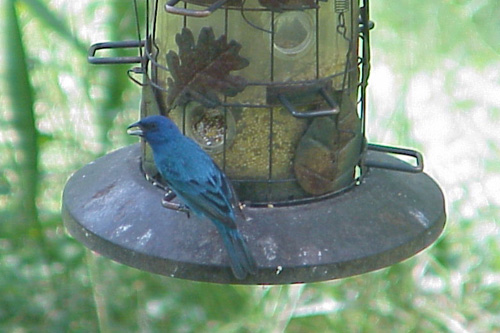
Indigo bunting at birdfeeder. Estill Co., KY.
(*photo by Sally Ramsdell)
August 3, 2014 They All Ate and Were Satisfied
The Gospel reading today (Matthew 14:13-21) tells us about the crowd following Jesus assembled in a deserted place; they became hungry with no ready means of obtaining food. The miracle leads to their being filled with bread and fish multiplied many times over. This is a human story of daily need for physical food while also continuously being spiritually hungry. We all seek enough of everything and yet purely material wants are limited while insatiable. Yes, the multiplication of loaves ended with the hungry five thousand being "satisfied" when what they received was miraculously-produced inherently limited bread. Paradox? The answer rests in the one who performed the wonder and what it fully signified. The entire event had deep spiritual significance for those who looked more deeply; Jesus being human satisfied an immediate hunger problem and opened the door to solving a longer term spiritual one through the offering of sacramental food that is satisfactory for the journey of faith.
Physical satisfaction may have a short-term result that can be described as "enough." If I like a certain seasonal fruit and find the taste for this August as just enough for the year, I can say it is satisfying -- though time will move on to the next period when the satisfaction would have to be renewed. In one sense, the taste was now satisfactory, though I realize the physical hunger will return again in due time, whether that be in a few hours for the next meal or a year from now for a repeat of the exquisite taste of the seasonal wild plum. Material things never totally satisfy.
Spiritual satisfaction is another matter. Just as Jesus blesses the loaves and fish offered for sharing, and this blessing become superabundance, so our blessings have deep spiritual meaning as well. Only God can satisfy our needs over a long period. When we say we are entering into the divine life in our everyday activities (when being right with the Lord), we come to realize that eternal satisfaction comes to those acting in a godly manner. The Kingdom of God is coming, but is already partly here giving us satisfaction to live as God wants us to, either here or beyond. In this sense, eternity's destiny is what makes sacramental food a wise and satisfactory investment. For believers who understand the deeper level of multiplication of loaves, this miracle is a curtain raiser to greater glory and a satisfactory conclusion to life.
Returning to the miracle account, immediately after the satisfaction of the hungry crowd the statement is made that the fragments that remained filled twelve baskets. This was saved for we are not to be wasteful tomorrow we will be hungry again. But more important is the opening to superabundance, namely that God satisfy us far beyond our expectations. Yes, our spiritual journey is not fulfilled yet and so we await a promise of eternity to come.
Prayer: Lord, help us to believe that one who comes to you will not go away hungry, and believers will not thirst again.

Close encounters with black bear.
(*photo by Doug Brown, Creative Commons)
August 4, 2014 Respect Black Bears
With greater frequency here in Appalachia we are encountering the black bear (Ursus americanus), a truly North American variety; its traditional range is much of Canada except Polar Regions along with all of the U.S. except the desert Southwest. And the bear's range extended into Mexico as well. However, over time through overhunting and habitat development and fragmentation that range has been reduced considerably, and black bears are now found in forty states. Rehabilitation is a major concern among conservation and wildlife biologists and wildlife managers, for the black bear is not prolific in reproduction, and returning to former numbers is a challenge and a little iffy. Further difficulty occurs with attempts to count black bears because of their secretive nature.
People like bears but not an unexpected meeting in the woods. I encountered my first black bear in Yellowstone National Park six decades ago. As with many Americans, the experience was both frightening and intriguing. We are drawn especially to cute cubs -- though that could trigger severe parental irritation. People make mistakes in trying to feed bears and do not realize that bears' poor eyesight could lead to bodily harm to the food donor. Furthermore, feeding bears encourages them to come around places of human habitation where pet, livestock, and human food are left outside. Through lack of discipline among inhabitants and visitors, harmful encounters do rarely occur.
Black bears have now returned to central Appalachia, but we hesitate to welcome them because we must learn respect in or near their presence. These bears are shy and not aggressive and need to be given their space to live, feed, reproduce, raise their young, and hibernate in winter. It means don't bother them; and this applies to our pet dogs as well. With proper care and space, people and bear can create a symbiotic relationship that allows all to prosper. What is somewhat divisive is the desire of hunters to use tracking devices and modern weaponry to hunt and kill these bears, to orphan the young, and to retard the rehabilitation process now underway. Certain bear parts, such as the gall bladder, have been prized by Asiatic and other peoples -- and this leads to some illegal poaching practices and the occurring threat to bear populations for the schemes of profiteers.
Friends of the black bear abound and they support research on bear attitudes, wildlife education, and reintroduction measures, as well as protection of existing bear habitats. The Appalachian Bear Rescue Center at Townsend, Tennessee, (near the Great Smoky Mountains National Park) has as one of its goals the rehabilitation of orphaned and injured bears for release back into the wild. It also runs exhibits and educational programs to teach people how to respect bears and be able to live near them in harmony. Contact: ABR, P.O. Box 364 Townsend, TN 37882.
Prayer: Lord, you give the world wonderful creatures worth
admiring and we are to gain respect for them and help them thrive.
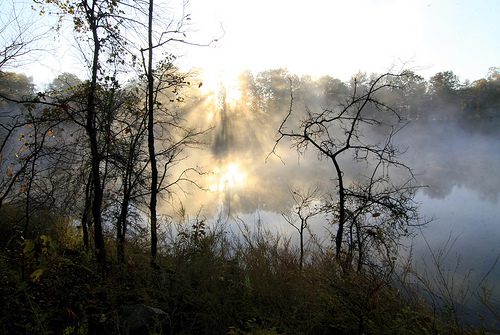
Sunrise atop a hazy Appalachian morning.
(*photo credit)
August 5, 2014 Protect Against Forest Fires
For those of us who live within National Forest boundary areas the thought of forest fires is never that far removed from possibility. The only good aspect of this over other natural and human-made disasters is that generally the alert of smoke smell and sight gives a little forewarning of what could damage property and threaten life. While mild forest fires have been beneficial for forest health, high-temperature and frequent ones occur due to droughts and thatch accumulation, especially in the western US. Factors that enhance the seriousness of forest fires today are:
Climate change. Let's face the facts that this phenomenon is leading to weather conditions including lightning strikes, dry conditions, low humidity, and high winds. Hotter summers and autumns can lead to possibilities of even more frequent forest fires. In fact, forest clearance through combustion leads to a major release of carbon dioxide that has just passed the global threshold of 400 parts per million, the highest level in 800,000 years. Without a heavy forest cover it will be more difficult to convert the CO2 back into stored organic matter.
Residences in forested areas. This upscale suburbanizing practice of building homes and especially luxury ones in fire-prone areas with enticing tree canopy may be coming to an end. Insurance rates are starting to skyrocket. When fires are detected, air tankers and fire fighters are brought even from distant states to reduce property loss -- at taxpayer expense. Complaints from forced evacuees that they did not have enough time to collect valuables certainly surface. Why defend luxury residences at the risk of the fire crews when common sense says not to put dwellings in fragile zones, or where abundant clearing are needed to reduce fire threats?
Tree dieback. Injury and destruction of a variety of tree species occur through invasive pests (pine beetle, etc.), as well as through the weakening of the native immune systems of the trees; this reduces the tree's ability to withstand natural pests. Dieback has led to added combustible material in many forests -- just inviting more major conflagrations to occur.
Arsonists and careless humans often start forest fires. In this age of terrorism, the possibility of a major fire is viewed by some as a tempting act of disruption. One little match; one big conflagration. I recall starting an Oregon campfire and the resinous thatch almost exploded -- and we quickly extinguished the camp fire. Arsonists are known to start fires because they enjoy the thrill of firefighting. Others are too careless to note hazardous conditions and posted fire warnings. Once on returning from church I noted a fire leading down into the woods from a drunk's lit cigarette; I extinguished it in the nick of time.
Prayer: Lord, help us to use wisely the great gift of fire.
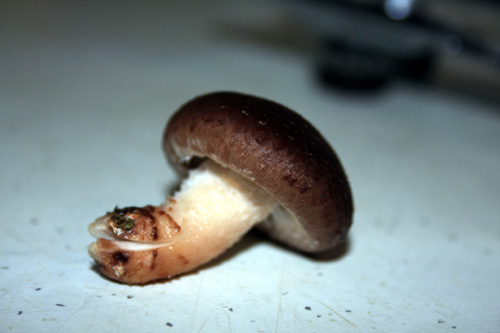
Summer harvest of Kentucky-grown shiitake mushrooms.
(*photo credit)
August 6, 2014 Transfiguration and Future Glory
There in their presence he was transfigured: His face shone like the sun and his clothes became as white as the light. (Matthew 17:2)
The Transfiguration is a unique event in Jesus' ministry, that restful moment when future glory shines through as though a sunburst on a cloudy day. This is the visible sign for the disciples that Jesus is the Father's beloved Son, one greater than Moses the lawgiver and Elijah the great prophet. But in this period before Jesus' passion and death there is the consolation that a brighter future is ahead, a foreshadowing of eternal glory. If we join the three apostles at the scene we need be more than observers; we are called to enter in the glorification that will culminate in the definitive coming of the Kingdom of God.
We accompany Jesus to the summit and stand beside him in his Transfiguration. But how? It has always baffled me how we can introduce this event into today's world, for it seems so unreal, so distant, so untouchable. Would a possible answer be that the full event for us is yet to come, that transfiguring has been initiated and we are part of the process? Our current actions in reclaiming the commons help glorify our wounded Earth in preparation for the coming of the Lord. Certainly we are struck by how we have damaged creation, and this event gives us courage to enter into the glorification process. Don't forget that this is Hiroshima Day.
The challenge to those with eyes of faith is to perceive glory emerging beyond current devastation and damage, and not to overlook the suffering but to see that nothing is lost. In one sense the caution that Jesus gives his disciples on coming down from the mountain applies to us as well. Let's not rest in our consolation in seeing the glory of God shining from the surface of this Earth. Accept the consolation as invigorating and penetrating our souls, but we are not to stop and rest alone; we need to redouble our efforts to assist others who are in need. We are energized to know both our limitations and God's promises of better times ahead. Yes, we can curb the anthropogenic climate change threats.
Urgency arises now for we cannot be totally environmental by settling on little bits of recycling. We must be willing to become countercultural, break with the consumer culture, and begin a process of redistributing the world's wealth for the good of everyone on this planet. We do not walk backward looking at past events as though they are the templates of the future, nor do we trip over present sufferers as we walk on clouds of future glory. We need to live fully so that we can join Jesus in his Transfiguration. Let's confront the climate change deniers and see hope ahead, even though the status quo is willing to fight back and insist that fossil fuels are part of the future.
Prayer: Lord, give us a glimpse of future glory for the sake of consoling encouragement needed for the awesome work of saving our threatened planet.

Brilliant lightning above rooftops.
(*photo credit)
August 7, 2014 Emergency Evacuation Plans
Many times in recent years with a variety of extreme weather conditions, evacuees report being only given a five minute or less notice to act. This condition is so frequent that we benefit by considering what could happen in case of forest fire, flood, hurricane, or in my case of living down wind from a chemical weapons storage facility (the largest in the world) mishap. Of course, the more warning time the better so that one can hastily gather all necessary items. But in case few precious moments are available, a workable plan to follow after evacuating all inhabitants as the obvious first priority is useful.
Most necessary items (2-minute notice):
* Keys to escape vehicle, hopefully with adequate fuel
* Shoes and minimal clothing
* Glasses and personal aids
* Wallet with personal identification and money
* Evacuation route
* Cell phone (if one is owned)
Next priority items (5-minute notice):
* Medicines for all family members
* Change of clothes and personal toiletries
(I keep a pack of these in the car)
* Pets, if transportable (some say "most necessary")
* Address book
* Prime computer disks or flash memory
* Flashlight and batteries (keep in car)
* Turn off utilities
Next priority items (10-minute notice):
* Favorite pictures of family and friends
* Financial records
* Computer, if portable
* Water supply (bottle plus gallon jug)
* Box of canned food and can opener
* Sleeping bags, pad and towels
Last priorities (20-minute):
* Bag of clothes for longer stay
* Books for reading
* Bag or cans of pet food
* Pillows and blankets including "crash" blanket
* Tent and camp stove
* Box of perishable foods
* Children's toys (if young ones are in party)
Some may want to equip the car with a battery radio with hand crank, emergency maps, and other items just in case. When not having private means of travel only the first two sets may be possible. Construct your own list and pray it is not needed.
Prayer: Lord, give me the gift of readiness at all times.
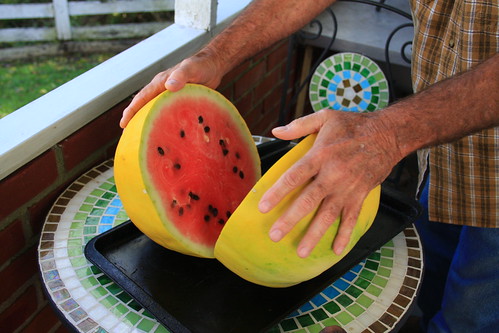
An heirloom "moon and stars" watermelon.
(*photo credit)
August 8, 2014 Return to Urban Victory Gardens
The numbers of those of us who remember World War II victory gardens shrinks with each passing year, now about 10% of our population. On the home front during that war, most people attempted to do their part in time of defense work, rationing, reduced travel, and growing victory gardens at some 30 million households. The entire effort was regarded as a success story, for the amount of food produced surprised the nation, especially realizing that fewer people than now lived outside of urban areas with plentiful suburban lawns. Cities were more congested and many families had less greenspace. All worked within their limits for a war effort that allowed overworked farmers to feed the military and send lend-lease supplies to Britain and other lands.
Victory gardens involve citizens turned gardeners. In the 1940s ordinary citizens rose to the occasion, from Rosie the riveter to Johnny the metals collector. Many had never before regarded themselves as gardeners and yet grouping during times of emergency they got enough help from experienced neighbors and relatives to rise on a fast learning curve. Their experience could be repeated today if we see the need to work together again.
Victory gardens furnish nutritious produce. Decentralized garden production allows for savings in fuel that would have gone into production and shipment of distant vegetables. Growing these near at home allows for far less food waste, more retained freshness in the produce, a sure awareness that no unwanted pesticide has been added, and an abundance of some items that can be exchanged or given to neighbors. Decentralization of food sources could improve and assure safety for the entire food system.
Victory gardens brighten our shared psyche. The times are not those of seven decades ago; then we had threats from foreign regimes; today we have a global climate change threat. Our growing a victory garden makes us aware that each can do a part in reducing non-renewable energy expenditure -- and this can bolster our collective ego. When each budding gardener goes outdoors and receives full spectrum sunlight and fresh air along with the physical exercise, a mood change occurs for the better. Gardening triggers our growth in psychological health and mental wellbeing.
Victory gardens change the urban landscape. America's backyards need not be kept in monocultural lawn, with all the mowing, spraying, and watering. The variety victory garden can be a success in saving resources and even allow the landscape to be more colorful when flowers are added in among the veggies and herbs. A transformation of lawn for new purposes can give neighbors the incentive to try to do the same. The will to flourish at the local level will have a ripple effect on more and more communities and grow throughout Earth's surface.
Prayer: Lord, help us to see successful change by doing simple things that can influence others to act accordingly.
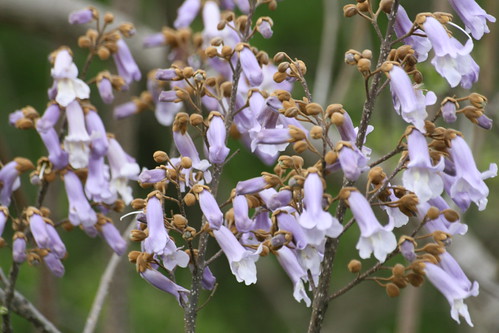
Royal paulownia, Paulownia tomentosa. Harlan Co., KY.
(*photo credit)
August 9, 2014 Nagasaki Day and Nuclear Power Abolition
This is Nagasaki Day, when we remember the terrible air strikes with two atomic bombs that caused 150,000 deaths and millions of injuries and shortened lives. The toll of innocent civilians was justified by policy makers as a way to shorten the Second World War. Then in guilt came the peacetime atom.
The offer by the industrial powers (United States, United Kingdom, France, Russia and China along with non-nuclear Germany) to permit nuclear power development in Iran, provided there was no nuclear materials for bombs, is part of the aftermath of the atom bombing. The unfounded theory is that nuclear materials can be kept out of the hands of terrorists -- and this has a dash of imprudence that threatens world peace. Certainly diplomacy is far better than military solutions. Isn't it rash to continue to pick fruit from the Tree of the Knowledge of Good and Evil?
To vacillate on the nuclear choice issue is dangerous in the long run. People who perceive this danger are either in the environmentalist camp of anti-nuke electricity generation, or from a pacifist and world peace position of no more nuclear weapons. The two could blend together; as one voice the call could be to destroy nuclear weapons and close nuclear power plants. The only tolerated radioactive materials should be relatively small amounts needed for operations in radiology and other medical treatments -- and hopefully even these may be replaced some day.
Will we succeed in our goal to rid the world of nuclear materials? There are really no two long-lasting options, for we as a world community play with radioactive fire and have been and can again be burnt badly. The burden rests upon our collective shoulders: to rid the world of radioactive materials, to protect our fragile world from nuclear holocaust, and to heal the wounds of past nuclear-related offenses. How did our country and others in the nuclear club become so arrogant as to think that they possess a certain grace to care rationally for such unmanageable weaponry, especially after Hiroshima and Nagasaki?
We must have faith that this joint nuclear abolition (weaponry and powerplant fuel source) occurs, but it will not be through some miraculous means. Today, some calling themselves environmentalists have joined the nuclear energy club, but their defection, saying erroneously that nukes could shorten the carbon imprint, should not hinder us. The best defense is an offense -- and this needs to be coupled with the many Japanese who have tasted the fruit of nuclear weaponry as well as the earthquake effects at the Fukashima powerplant accident. We need to present an ultimatum -- a moral blueprint, a practical outline. There is no need to regard these two very serious issues as separate. Let's act in unison.
Prayer: Lord give us the faith it takes to get rid of nuclear materials for the human race cannot safely handle these materials
in arsenals or at powerplant sites.
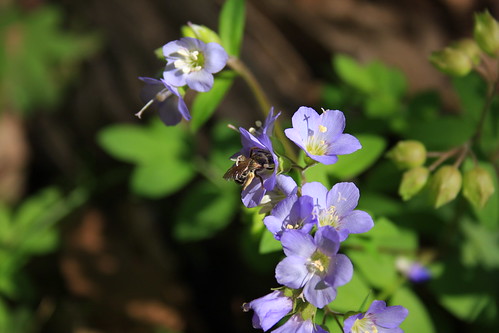
Honeybee foraging on Jacob's ladder, Polemonium reptens.
(*photo credit)
August 10, 2004 Placing Our Troubles with the Lord
Lord, tell me to come to you across the water. (Matthew 14:28)
Perhaps you are like me and have endured a storm at sea that was somewhat frightening. We hear stories such as the consequences of a Perfect Storm, ones where all the conditions combine to create costly sea disasters. At the shore at Gloucester, Massachusetts is a monument to all the local fishermen who lost their lives at sea from pursuing a dangerous occupation. Recall that many of the Apostles were fishermen and thus had reason, when they were caught on the sea in a storm, to pray. And then they saw the Lord walking toward them upon the stormy sea.
Individually, we have our storms in life and from experience we know how to be afraid of what could follow if things go wrong. Individually we are in need and reach out to others for help. It is hard to go it alone and somehow at least the compassion of others helps, for loneliness is devastating. We all seem powerless and so that is that moment of grace when the sufferer calls out to God for help. We beg the prayerful question of Jesus on the cross, Why have you forsaken me? And somewhere in the recesses of our soul we receive the light in the midst of darkness that God is truly with us, ready to see us through.
Socially, we are part of a community that experiences as a group what individuals who feel forsaken undergo. We reach out to others within our ranks and discover that we all ail from similar weaknesses and thus have even a social loneliness to endure. A believing community speaks in prayer: WE are poor and need our Lord to assist us for we cannot pull ourselves up by our own bootstraps. "We need you Lord as our source and guide." We are part of a socially addicted society where mammon has so enthralled us that we can become blinded by past success and expect in pride to rise up by ourselves. What if all of us in the human family are addicted if not personally, at least with the fear of being impotent?
We see Jesus walking on the turbulent waters of our age, and feel the swaying of our society in the storms of materialism. And the ghastly fear descends that our technology can't save us. Across the horizon is a spirit coming towards us. Our faith tells us to look out and see. We are not alone! We have another loving us and coming to us if we only reach out to a Higher Power, a companion in time of need. Only then can materialism be seen for what it is, and the peace of spiritual calm come upon our world. WE are dependent people and in accepting this fact we are then empowered by the Lord. Without God we are powerless; with the Lord we become instruments of his healing power.
Prayer: Lord, draw our attention to our national motto "In God we trust." Help us pause a moment and make a deeper reflection both individually and collectively, for in you and only you we find our true security and power to heal a troubled world.
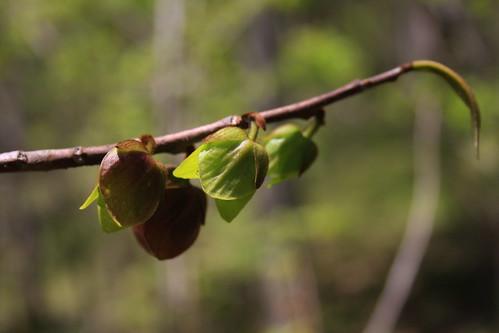
Home orchard of pawpaws, Assimina triloba, in flower.
(*photo credit)
August 11, 2014 Ten Proven Ways to Reduce Grocery Bills
Resource conservation includes curbing expenses where and when possible. For those of us striving to meet food costs, these saving suggestions may help balance hard-pressed budgets:
* The greatest savings comes from growing one's own produce and that applies especially to organic salad greens, either in pots or greenhouse in winter or in the garden space during spring through autumn. All too often fresh salads can have contamination and part of what is paid for is long distance transport;
* Herbal teas are surprisingly a second great savings, because so many mints and other herbs can be grown well in small spaces or pots. Remember that imported coffee and tea, along with soft drinks, are sizeable parts of a food budget without being food;
* Avoid prepared foods as much as possible. Make your own soup using homegrown vegetables and leftovers and do this in a creative manner. Cans of prepared pasta dishes verge on being junk; salad can be prepared at home together with baked materials if one has the time to do so;
* Comparison shopping is a major savings area. Assemble a listing of common purchases and even patronize two locations if there are mixed savings among stores;
* Choose snack food wisely. Far better to snack on carrots and celery, or dried fruit and whole nuts than the prepared varieties of snacks coming in those fluffy bags of chips;
* Bulk purchases are a saving that many overlook. Much depends on variety of stores available where comparison shopping may occur. Dried beans and other legumes, rice and other whole grains, and cooking oil are prime targets for bulk purchases. Buy off-brands and generic brands if the quality equals or nearly equals the better-known, higher-priced name brands. This holds for everything from breakfast cereals to canned vegetables.
* Opportunity sales. Follow the sales and purchase canned goods and other items that can be stored easily. When seasonal foods such as cucumbers and tomatoes are on sale, they can be preserved through canning, pickling, drying, and deep freezing;
* Stick to shopping list. Avoid impulsive buying when at the store. Don't shop when hungry, for junk foods may appear tempting;
* Prefer seasonal foods, for these cost far less than the same product purchased out of season and shipped long distances. The local surplus produce costs less as the season advances; and
* Curb meat purchases and saving will occur quickly.
Prayer: Lord, teach us to share our budget with the hungry.
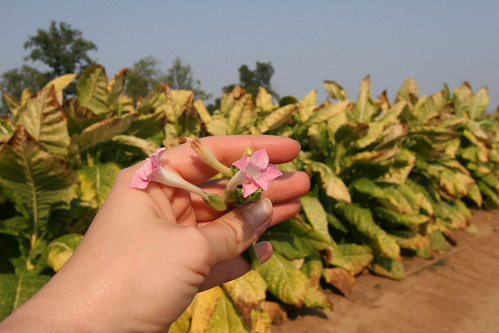
Flowers of tobacco plant. Pin Oak Farm, University of Kentucky.
(*photo credit)
August 12, 2014 August Was a Harvest Time for Tobacco
Many memories of happy harvests still captivate me, especially in the month of August, with fruit and vegetables as well as hay and silage corn/sorghum, as well as our principal cash crop tobacco all needed tending. The happiness of youth helping with the joint family effort at survival is regarded with some ambivalence today, for young people should not have to work and tobacco's application leads to addicted smokers with their hacking, coughing, and gasping for breath. We thought our tobacco product, with its high quality golden leaf, was meant to give enjoyment to multitudes and relief of tensions to soldiers on battlefields. What about the sixty-four actual smokers somewhere out there who had their lives shortened by the tobacco that I assisted in growing over the seasons? Sobering!
Tobacco fields are still beautiful if seen when unattached to human aftereffects. It is much like a field of Afghanistan poppies, when divorced from the heroin and opium addicts who will use the processed sap from the plants. We know too much now! When young, the horrors of smoking were not known and, in fact, the best of the doctors advised their own particular brands of cigarettes for health "fitness" and wellbeing. We were patriotic and cooperated in furnishing cigarettes for fighting forces in Europe and the Pacific war theaters. All felt satisfied: farmers, merchants, tobacco product manufacturers, the government with all that tax revenue, and even the health professionals. But that was to change during the ensuing decades.
Tobacco was our major money crop; it paid for our clothes and shoes and even our college tuition. The tobacco plant produces a beautiful fragrant pink and white tubular blossom that attracts hummingbirds. Tobacco patches minus pesticides are homes for the preying mantis, which preys on tobacco worms at this time of year. The fields are pale green to slight yellow as the plant ripens for the cutting -- and mid-August is the climax of the tobacco agricultural season when the crop awaits being "housed."
Let's yearn for the day the innocent tobacco plant may be redeemed by the better uses that human beings can make of this quite amazing plant. (See Tobacco Days on Brassica Books). In due time tobacco will become the source of new pharmaceuticals; a promising industry can use the plant as a medicinal cultivar for making cheaper prescription drugs and preparations for ill folks. This will be promoted even while the number of tobacco patches will diminish and those remaining subject to highly specific controls on how the crop is grown. If I live so long, the tobacco patch will again be attractive in scent, sight, and as a producer of beneficial substances. Then harvest time will once more be a blessed time of year for all crops and not just select ones.
Prayer: Teach us, Lord, to be people who learn lessons from past misuse of our products and, over time, to change our practices so they benefit all our brothers and sisters.

Late summer view of Kentucky's Natural Bridge.
(*photo by Chris Hardie, Creative Commons)
August 13, 2014 Visit Kentucky's Natural Bridge
Within our Stanton, Kentucky parish boundaries is a majestic natural bridge, a rock formation of exquisite beauty. This beckons one to approach on foot because it is difficult to observe from a distance unless one ventures overhead in a helicopter or airplane. You see, it is located at a high ridge with no distant higher observation points on which one can view nature's true grandeur. In winter when trees are leafless there's an opportunity to view it from a distance. For naturalists, the bridge invites you to experience it firsthand after a quarter-mile uphill hike, or take a cable ride.
Once visitors approach the bridge, they have to go through a narrow alleyway between two massive boulders. As a youth on my first visit I wondered whether any exceptionally obese person ever got wedged in this two-foot-wide passageway. Once on top, the experience is thrilling; the narrow walkway span on the bridge's summit makes those afraid of heights somewhat scared because it is a hundred-foot drop in either direction. Nearby at the approach to the bridge is a covered viewing pavilion where one can rest, view the picturesque landscape, and prepare for the descent to the park.
I visit this Natural Bridge State Park often and have gotten to know its layout; I have made several of my annual retreats in the primitive camping area along a flowing brook. I enjoy the hikes and jogs, to pick wineberries in July, and watch the wild ducks as they glide through the pooled waters of the creek. Yes, I have even performed a funeral for James King in the private family cemetery predating the park's creation, right smack in the middle of the park. That burial bonded me to the park in a special way for I like the setting, management, access roads, and general facilities for eating and camping. Visitors are a happy lot, enjoy the beauty, and for the most part respect the treasures, speaking favorably of the recreation programs and nature tours.
Kentucky is proud of its state park system, and Natural Bridge is regarded as the heart of eco-tourism within Kentucky's recreational network. This is located in the heart of the Mixed Mesophytic Forest, the oldest temperate forest in the world. The rock formations are unique and the adjacent wilderness area attracts rock climbers from all parts of the Midwest. In fact, the combined park/wilderness areas attract about one million visitors each year. Lodging and camping facilities are adequate for the visitors' volume; grounds are well maintained and policed. Trails are well marked with rest areas, and steep grades with railings and steps. A nearby U.S. forest Service visitor's center gives a complete geological and cultural history of the area. Plan summer lodging ahead of time due to popularity. Come, visit and celebrate Sunday liturgy with us at the county seat, Stanton.
Prayer: Lord, give us choice places to come, enjoy the green landscape and blue skies, hear the wild sounds, and experience the natural scents and unique tastes of sacred space.

Sisyrinchium angustifolium, blue-eyed grass.
(*photo credit)
August 14, 2014 Attempting to Be Godly
Saints are people with a wide variety of gifts and personalities. It gives us heart to discover ordinary people who made the grade and who inspire us to follow their example on the road to holiness. We are able to number a host of good qualities that can identify them as godly in their actions. These include:
* Having a basic joy and enthusiasm in their lot in life;
* Seeing others as better than themselves;
* Understanding the meaning of forgiveness;
* Being calm amid the storms in which they found themselves;
* Presenting a countercultural stance before the world;
* Refusing to yield to allurements of mammon;
* Leaving judgments about others to the Lord;
* Seeking ways of motivating and encouraging others;
* Bearing up with pain and suffering as part of life;
* Showing a gift of joy in all undertakings;
* Using all things in moderation;
* Finding Christ's image in works performed;
* Expressing compassion with those encountered;
* Listening intensely at all times;
* Refusing to show partiality in dealings with others;
* Being silent when needed, and speaking out when called;
* Accepting attacks of others with equanimity;
* Learning from imperfections of the past;
* Demonstrating self-discipline in moments of temptation;
* Wanting to share good things with others;
* Exuding an atmosphere of eager learning and curiosity;
* Being slow to cast blame on others;
* Admitting weakness and limits in certain areas;
* Maintaining a prayerful spirit for long periods;
* Manifesting sensitivity to plants and animals;
* Never being wasteful with resources at hand;
* Being acutely aware of the shortness of life;
* Speaking sincerely about the things of heaven;
* Respecting the gifts of others and wishing them success;
* Being humble about one's station in life;
* Tending to be physically and mentally healthy;
* Laughing, smiling, and showing good humor in ordinary ways;
* Sensing and helping when others are hurt;
* Taking time to talk to others and not talking about others;
* Believing firmly that good will come from the situation;
* Hoping for salvation;
* Loving all;
* Expressing honesty in all business dealings;
* Looking ahead to the horizon in the journey of life:
* Praising God for all of creation;
* Extending blessings to everyone;
* Thanking others for favors; and
* Showing constant gratitude to God for gifts given.
Prayer: Lord, the list just given is long; keep me from being
discouraged by its length and content.

Our Lady of Guadalupe at Good Shepherd Catholic Church. Frankfort, KY.
(*photo credit)
August 15, 2014 Mortal Mary Leads the Way
"When the course of her earthly life was finished," the Blessed Virgin Mary "was taken up body and soul into the glory of heaven." Pius XII, 1950.
The most important moment in all of our lives is the hour of our passing into eternity. All our earthly activities culminate in the one grand exit from this mortal stage. All human beings must undergo this passage in some format, even the privileged Virgin Mary. Elijah went up into heaven in a chariot and Hebrew tradition has Moses making such an eternal exit without leaving a designated burial place. Today we commemorate Mary's special and unusual passage, the first fruits of the Resurrection of the Lord (I Corinthians 15:20-27).
The Assumption is a very ancient feast in the Christian world. The Orthodox call this feast the Dormition ("falling asleep") of Mary. The feast is celebrated in the Church of England, Episcopal Church in the USA, and the Evangelical Lutheran Church of America.
Through the many Hail Marys offered each day, faithful Catholic petitioners beg that we be remembered by Mary "now and at the hour of our death." Amazingly, that petition is often answered as there is testimony to the happy death of many faithful in their last moments -- and I will attest to this. Just arriving with the final sacraments at the right time is part of that spiritual reality that those in ministries affirm. Why is Mary so anxious to assist each of us at this phase of life? She was specially chosen for bearer of divinity after making a monumental choice; she witnessed Jesus' beginnings of public ministry, his suffering and death upon a cross, and then after the resurrection the birth of the Church at Pentecost. Then she was assumed into Heaven.
We are chosen by God from eternity to undertake our special mission, though of humble ranking. Through baptism we are immaculately ushered into the Church as a member of Christ's body; we hear our own humble call in a unique manner; we are bearers of the Lord at Communion time; we encounter Mary's Son in our journey of faith, which involves public ministry and ultimate sacrifice; we die to self and rise with Christ; we await the rising of the body on the last day. Our journey of faith has some similarities to Mary's, and after death ultimately the body will be glorified.
We encounter Christ sacramentally and this is an introduction to the eternal life to which the faithful are called. How do we experience God in living so that we can do so in dying a happy death much like Mary's happy passing? We often fear dying even though as we age we may anticipate the afterlife happily. For all, the passing is a trying moment when we need the companionship of Jesus and Mary, when angels hover over and a final curtain rises. In faith we celebrate Mary's day and ours as well.
Prayer: Lord, may Mary be at our side at the hour of our death.

A burst of color in the forest behind the Mary E. Fritsch Nature Center, ASPI.
(*photo credit)
August 16, 2014 Mixed Mesophytic Forest
In this part of Central Appalachia we are blessed with the treasure of the "Mixed Mesophytic Forest," which stretches from southwestern Pennsylvania to northern Alabama and covers a strip of mountains as well as the Cumberland Plateau. The forest name was given by a noted botanist and ecologist, Lucy Braun (1889-1917), who knew this region well and identified some 12,000 plant species in the course of her lifetime. Naturalists are well aware of this regional jewel, but many others take it for granted or focus only on the scars and damage done by extractive industries.
The "mixed" part of the basic terminology refers to the 30- some canopy trees that appear to predominate in various places and are thus called oak-hickory, beech-maple, oak-pine, etc. On the ASPI center grounds, forest expert Paul Kalisz labeled over one hundred different native tree and woody species and that does not count the American chestnut, which has been recently reintroduced. The variety of these woody species in any one temperate (not a tropical) forest is mind-boggling. This forest is regarded as the relic of the ancient mesic forests that once covered much of the temperate regions of the Northern Hemisphere. This forest area escaped the last ice age, and is thus regarded as the oldest and most varied temperate forest in the world.
Not only is this forested area noted for its many tree varieties, but the wooded landscape contains rich understories of fungi, ferns, small trees and shrubs, herbaceous plants, a multitude of wild flowers, and a variety of animal wildlife species. For millennia, the region abounded in elk, deer, bear, wolf, fox, snakes, opossum, raccoon, beaver, rabbit, turkey, and some two hundred species of migratory or resident birds. The creeks teemed with mussels of many varieties, along with fish and crayfish, frogs and salamanders. The mountains abound.
Our forest wealth here and throughout the world needs to be maintained properly and protected against destructive logging practices. The lungs of Earth are worth proper care. So often the resident population as well as ordinary visitors, do not appreciate the uniqueness and fragility of the biological diversity. This diversity certainly is of greater value than extracting logs, coal, and other resources that can threaten forest integrity and permit loss of species and opening to exotic species. The systematic damage done in this region is highly researched and recognized by the academic community. Furthermore, our nation has the scientific know-how and resources to support the U.S. Forest Service efforts. Nature centers such as at ASPI celebrate this unique forest wealth; teachers and students discover the gem in which they live, and all can demand safeguards for the health of this unique "mixed mesophytic forest." Come and visit a true remnant from the past and learn much about the Appalachian environment.
Prayer: Lord, teach us to respect our forestlands and to
discover the many species that thrive within them.
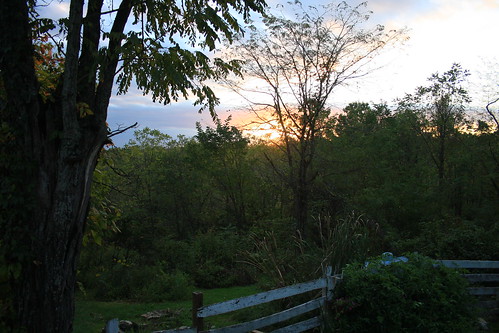
Hazy mid-August sunrise.
(*photo credit)
August 17, 2014 A House of Prayer for All the Peoples
Woman, you have great faith! Your wish will come to pass.
(Matthew 15:27)
The Prophet Isaiah tells us in Chapter 56:6-7 that foreigners who come and obey the rules and show God reverence will be made joyful in the house of prayer. The prophet speaks to an audience of the faithful who were to prepare the way for the Messiah. But where were the limits and how broad was the audience? This question awaited interpretation and application. Jesus quotes the phrase found in this passage when he drives the money changers from the Temple; these profit-takers had turned what was a commons "For all the people" into an arena for their own special interests.
The quote above was from Jesus to a Canaanite woman who came to him from the Tyre and Sidon district (outside of the Holy Land of his time); she pleaded over and over that he might heal her daughter. Jesus appears to rebuke her at first in strong language, since his ministry did not extend into her territory, but she responds simply and humbly to the rebuke. Jesus sees that a broader world contains people who have great faith. The words of this Gospel passage and those of Isaiah many centuries before present a fitting opening for spreading the Good News throughout the world. All peoples include those who wish to come onto the holy mountain and all receive the invitation to come.
As followers of Christ we too have our time and space; we are gifted with a limited span of life and amount of energy. Teach us to count how few days we have and so gain wisdom of heart (Psalm 90: 12). Choices as to what to say and where to go are needed throughout, and this becomes more imperative with shortened time. But then we in a prophetic manner observe that golden moments of ministry come in unexpected times and places, and so we need to be alert to opportunities to encourage the poor to rise to the occasion and exert themselves.
A world of humble people awaits the good news. Our zeal to make room for them is part of spreading the Good News. We are the ones called to be sensitive to their particular needs and make sure that the commons is meant for everyone. Their humble faith is as precious jewels in the treasure worth digging up, and we are called to do the spade work to uncover jewels that will sparkle for all the world to see. In the late summer of life we pray that we show equanimity to all. This demands a sensitivity that can easily be blinded by mammon and the cares of the world. Billions of brothers and sisters are out there seeking a better quality of life. We are meant to be like Jesus, meeting them in their needs, and encouraging a global solidarity among the many who are comfortable being associated with the other poor ones.
Prayer: God, give us the spiritual vision to see the choice moments when we discover authentic needs and the people who will lead the way to bringing about radical sharing of resources.

Bald eagle, nesting. Fort Donelson, KY.
(*Photo by S. Somero, Creative Commons)
August 18, 2014 Welcoming Back the Bald Eagle
We celebrate "bald eagle days" this week. The American bald eagle (Haliaetus leucocephalus and not Ben Franklin's suggested wild turkey) is our national bird. American eagles are truly majestic with white-feathered head and neck and an alert fierceness, vigilance in stance, and speed when swooping onto prey. Yes, Roman soldiers marched behind eagle standards, and millions of others before the double eagle of Russian czars' insignias; eagles were models for military and athletic battles through the ages.
These powerful raptors enjoy a wide menu of possible victims and they are known to attain flying speeds of thirty miles per hour and for diving at 100 miles per hour. Adult males can weigh nine pounds and the adult females twelve to thirteen pounds. The wingspan of adult eagles can reach seven feet. Through keen eyesight the eagle can spot fish a mile away and capture those up to five pounds. Eagles are known to paddle to shore with heavy fish that they cannot lift by their wings, and in some cases they drown when trying to transport larger fish. Eagles can live to be thirty-five years old in the wild and a decade or so more in captivity. They acquire characteristic white feathered head and neck as part of maturation and wear it proudly in their conquests.
For a period of time immediately after the Second World War when chemical pesticides came into prominent use, the egg shells of eagles and other birds were so weakened by the pervasive pollution that many eaglets did not hatch, and far fewer young ones survived to maturity. Eagle populations plummeted and the American bird was placed on the list of endangered species in 1978. Alarm was raised across the country, and conservationists raised a rallying cry to save the bald eagle. The endangered listing was later changed to "threatened" on August 11, 1995, and the bird is still protected by the Endangered Species Act, the Bald Eagle Protection Act and the Migratory Bird Treaty Act.
Today the bald eagle report is somewhat improving. The bald eagle is now appearing in numerous locations throughout the country and sightings are commonplace. I never forget the thrill of seeing one for the first time when in southern Louisiana. Since then many sightings occur in Appalachia and the eagle is again here to stay. Endangered Species regulations do work and reintroduction programs are healthy and well -- once the use of DDT and related pesticides were severely curtailed. Our American raptors truly fill a niche in the environment and are not just caged in zoological gardens or stuffed on museum shelves.
While with great attention we have been able to protect, save and celebrate the return to health of the bald eagle species, still other less-known bird species are endangered by loss of habitat or other threats. Let's broaden attention to them as well.
Prayer: Lord, allow us to admire the majesty of eagles and to see in them your greatness and power.
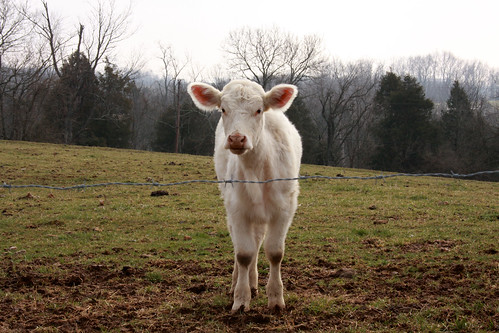
Kentucky cow pasture. Mercer Co., KY.
(*photo credit)
August 19, 2014 The Art of Herding Cattle
I would prefer not to herd livestock but have them follow as do sheep -- and in one case of mine a cow and her calf did do that just before a storm. Cattle herders, like shepherds and cowboys, can be considered noble occupations. Those who have handled livestock learn the tricks to the trade, to think like and outmaneuver the runaway calf or lost sheep.
Herding includes the practice of gathering in livestock for milking, changing pastures, or sheltering them from a storm. I remember the time a small plane ran out of fuel and landed on our pasture; a neighbor came over and said the pilot was running in circles as the cows wanted to charge and butt his small strange aircraft in their pasture -- for cows can be terribly curious. We left the dinner table and went quickly to use herding talents to move the rambunctious herd to another field and help the poor fellow out; we also had to go to the local airport to buy some fuel and make him a runway to get him into the air again.
Cattle can be quite content when provided with good feed and shelter in the worst weather. However, they always seem to have a sixth sense in knowing when abrupt changes are approaching. They know when that contentment is disturbed by an abrupt change in living conditions. Here our attempts at gathering them to be loaded in a truck for moving elsewhere tried our skills to the utmost. We had to outmatch their desire to remain in the status quo. It was as though we had to think like cattle, if that were possible, and utterly outwit them.
To the neutral observer handling livestock seems easier than it really is, even when rounding up rather gentle beasts. The term "herding" applies not only to those who execute a successful lassoing of an energetic steer, but also to those of us who herded on foot or with a motorized vehicle. One must induce the animal to move where intended, and most often cattle think otherwise. The animals are basically conservative and do not like change, even when they somehow know it is inevitable. Ordinary bovine instincts are predictable to those who know the animals. For the experienced, which way the cow will turn is not a total mystery, though young heifers are actually less predictable.
Only on rare occasions will a mature cow make an unexpected turn to break away. Driving them does not necessarily take a large number of herders. The tendency of cattle or bison (though who'd want to herd the latter?) is to stick together and stay near their natural leader. This means the herder has to recognize leaders and give special attention to them. The game's object is to anticipate a lead cows moves and block her before she executes wrong ones. Timing is crucial, for herding is a form of focusing, and can be a challenge to the inexperienced.
Prayer: Lord, help us to gather in our random thoughts, for our reflections need herding to make this day meaningful.

Male towhee, quiet observation.
(*Photo by Sally Ramsdell.)
August 20, 2014 Promote Camping as Recreation
Camping is both art and recreation. It takes an artist to set up the experience so it is enjoyable; it takes observation to find ideal settings, equipment to be comfortable, and opportunities to enjoy the experience. Certainly with care being outdoors in nature is a wonderful undertaking that can occur in all seasons, provided we have the proper gear for inclement weather (snow, rain, hail, etc.), and the willingness to endure the elements.
Nature invites us outdoors. I have had a long experience with camping (47 states and several provinces of Canada), but that become restricted through aging -- though my hope is that this treatment is encouraging for younger folks. Some of my first camping seven decades ago was as scouts; we learned to choose the right spot, make campfires, and cook simple meals. Actually, camping can be quite simple, even if we have to retrieve plastic sheeting instead of a tent, or a blanket or coverlet instead of a sleeping bag, or a ground mat made of leaves instead of professional pads. Commercial outfits want the camper to use their expensive but comfortable equipment, but with a little forethought we learn that these items are not essential. However, good backpacks are needed for hiking and camping.
One does not have to make long distance trips to enjoy camping. Encourage youngsters to do so near home for starters, and to consider camping in home surroundings as an experience to gaze at the stars at night or enjoy an outdoor meal or conversation. Being with nature in the "wild" becomes truly a learning experience and so creating your own setting is creating a recreational pattern that could continue through life. Traveling long distances by car consumes fuel, is exhausting, but is not camping. Selecting sites requiring less effort is part of the total experience.
Enjoyment of nature away from buildings and congestion is a key component of the camping experience. We begin to see our place as midway between the macrocosmos out there in the heavenly expanse, and by looking down to earth with its near infinite variety of plant and animal life forms. Be ready for the unexpected: prepare for a curious wildcat to visit the camp site, or discover a wildflower not seen before. A high point can be experiencing the sunrise while outdoors or observing a sunset as the day ends. It could be hearing the stream's running water; particular times and places come to mind, for camping can have lasting memories -- good and challenging.
Two additional notes: consider camping to be a time for reflection and prayer. That comes more with aging because we start to see that camping days are fewer and we must make the best with limited time. Also record camping ventures, for there is pleasure in returning to the particular place and time through review.
Prayer: Lord, we are people on the road. Help us to symbolize this through our recreational activities.

Male sheep enjoys fresh foliage. Madison Co., KY.
(*photo credit)
August 21, 2014 Consider the "Walmartization" of America
Forgive me, for perhaps I've coined this new word? If so, it needs little explanation, because readers sense what "walmartization" is all about. Each of us hears about local businesses that simply cannot compete in prices when the monstrous Walmart is situated in their midst. I know of a business of three generations located in the center of a county seat, the owner of which says it is only a matter of time before Walmart forces him to close. His hardware is excellent, and the tools never bend at the first stroke. True, they are higher priced, but of dependable quality. Many modern Americans prefer to do one-stop shopping -- for clothes, toys, gifts, school supplies, kitchenware, sports wear, groceries, hardware, furnishings, personal items, lunch, tires, gasoline, and eyeglasses. For they choose to battle crowds to get what they regard as bargains within the "Big Box."
What seems too good to be true is exactly that -- too good. What about employees? What about quality of products? On the plus side are plentiful supplies of low-priced items, which seem to be bargains. But what about the faceless attending workers? Stories abound of provisional workers, who come on time as directed and then are accepted or dismissed without any forewarning. The store's wages are not high for these non-unionized clerks, but in the race to the bottom there are other folks wanting to take their places. And many employees do not have benefits. A second point is that merchandise is often from other countries and some is deliberately priced to undersell local competitors.
Then there is what happens to the town itself when the Walmart comes. Business suddenly drifts in the direction of the Walmart and the traditional commercial district dries up. At least those who scramble to locate near to the Walmart to attract some of the spill over may be saved by the size of the gathering; more distant stores often wither and die. Walmart's outside personnel decides the life and death of communities that have thrived for decades, and this victory is generally achieved through development of previous greenspace for acres of new parking and store roof.
Big-box profits do not stay in the community as they did when individual local people ran the shops selling the various types of merchandise. Occasionally Walmart tries to show its "good neighbor" policy and support a local enterprise or operation -- but that is not a consistent policy, nor does it encourage store administration to be prominent in civic activities, nor allow its employees to unionize -- a basic worker right. Walmart is a slick outside operation that comes in and reaps the local people's money, and no wonder Big-box family owners are billionaires. Money goes elsewhere, draining the basic investment policy of local communities. Keeping resources at home is better.
Prayer: Lord, give us an understanding of working at the local level and to insist that all workers be treated fairly and that all citizens benefit from each others trade.

Late summer bouquet. Rudbeckia and echinacea.
(*photo credit)
August 22, 2014 Thomas More: The Man for All Seasons
A person who attracted my attention for decades is the Englishman, lawyer, author of Utopia, husband, father, widower, member of parliament, ascetic, speaker of the House of Commons, naturalist, confidant of the king, chancellor of the realm, and sainted martyr -- Thomas More (1478-1535). The many grand contrasts in his life could indicate why Robert Bold entitled his splendid play The Man for All Seasons (1966) and why a subsequent movie was given the same name. Here are some of the contrasts:
We call him "Sir" in relation to the secular work and title given by King Henry VIII; he is a "Saint," in part due to the same king condemning him to death and More's martyrdom. The different seasons were summer in Henry VIII's favor and winter in disfavor.
Thomas was an affluent person in the early part of life with a father who was a prominent lawyer and judge, his own renowned education, his intermingling with influential people of the times, and his command of the language that allowed for an early writing success with Utopia. Thomas and his family were cast into poverty by the king's disfavor, and when he died he was uncertain how his wife and children would continue without property or means.
Thomas was a man of wit and humor and yet cast into some dreadful times when the Church he loved was deprived of its organization and leaders. He observed Bishop John Fisher being led to martyrdom and beheaded with his head hung on London Bridge. Though Thomas' own head would be so placed a few days later, he kept his humor in even his last remarks. The clouds of a crumbling church structure did not destroy his peace of soul.
Thomas was able to write under a variety of circumstances, first when in communication with other Renaissance personages, and later while isolated in the Tower of London the Treatise on the Passion of Christ and the Dialogue of Comfort Against Tribulation.
Thomas chose strict discipline in the practice of his faith, with wearing a hair shirt and daily recitation of certain liturgical prayers with his family. He was not a vowed religious person, but rather a married man raising a family while he engaged in making a living as a layman balancing work and total sacrifice -- rare then and rare now.
Probably the most surprising contrast is that even though he was canonized by the Catholic Church in 1935 and shares a feast today with John Fisher, he is also honored by the Church of England on July 6th. Furthermore, famous portraits of Thomas (by Hans Holbein) hang in the Royal collection at Windsor as well as in the National Portrait Gallery in London and the Frick Collection in New York, even though his head hung on London Bridge.
Prayer: Help us, Lord, to seek the intercession of Thomas More when we go through the trials of our ordinary living circumstances.
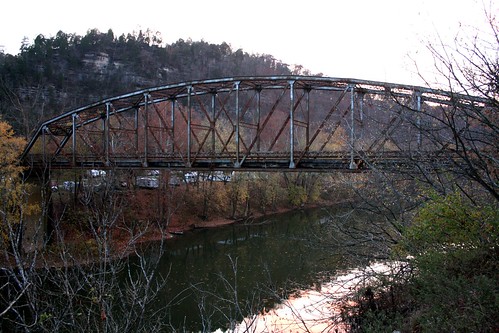
Abandoned Camp Nelson (Kentucky) bridge.
(*Photo by C Hanchey, Creative Commons)
August 23, 2014 Support the Veterans History Project
A number of opportunities have arisen over my past decade of pastoral work to actually record the life stories of parishioners who are veterans. We have sent four of these to the Library of Congress's Veterans History Project. My only regret is that on two other occasions vets over ninety were unable to recount lucid stories of their service time. Memories are fragile and fade with time into a pleasant or unpleasant cloud. The lesson learned is that veteran experiences need retrieving during a specific time.
Our half-hour videotaped interviews uncover some very interesting feats by these highly decorated vets who humbly gave service to their country. Bud merited the Silver Star along with numerous other medals for his Army career in combat action, along with a subsequent bout in the Navy. Russell, a young marine who suddenly became an adult in combat, managed to survive his similar thirteen-month Korean tour when many of his buddies did not. He notes that he did not remove his boots for six months. Russell tells in a matter-of-fact manner how he was near an exploding shell; shrapnel broke the stock of his gun and blew off his helmet, and one piece (he has it as a souvenir) embedded itself in his prayerbook in his shirt pocket over his heart. For Russell, that was a moment of faith conversion.
These exploits, told with much emotion, are now preserved in a Project that has tens of thousands of contributions. These are truly a valuable and fragile part of America's history, and preservation depends on our extra efforts to record exploits and mental attitudes that are sometimes difficult to narrate. Certainly, those friends and loved ones will gain much from the videotapes as will people who do not know but are impressed by the recorded deeds. As a pastor, I regard their stories as part of the Good News that means so much to all of us. Both patriotism and resource conservation calls for preserving these stories from the past. Certainly, I have been deeply inspired by a willingness to share the past as part of the total duty on the part of vets. Bud's hospice worker listened with absolute amazement about his feats, as did Russell's wife who never had heard these before.
This project has great potential, though we must be sensitive to some who prefer not to tell their stories. War is never pretty and veterans are the first to admit it. War leaves scars that are deep and survivors who are burdened with unpleasant memories, some worth unloading and some to be honored to remain private. Vets may see current news episodes of atrocities recounted in the media as opening old wounds and this adds to past war damage. If interested in finding willing story tellers and contributing to this Project, contact the American Folklife Center, U.S. Library of Congress, 101 Independence Ave., S.E., Washington, DC 20540-4615 <www.Joc.gov/vets/>.
Prayer: Lord, teach us to preserve the treasures of memory for the sake of loved one and those who can learn from past heroes.

Soapwort, Saponaria officinalis.
(*photo credit)
August 24, 2014 The Pope as Rock in the Storm
For a pope who has been in office for less than a year and a half, Francis has certainly made a mark on the entire world. In watching and hearing him (via electronic media) we are able to see a person connected with ordinary people, who is willing to be quite visible, and who is the joyful answer to our prayers. I take a special solemn vow to go wherever the Pope wants to send me and that is environmental in scope. He was a friend on our Facebook page at the time of his election, and I strive to defend his clear stance on the connection between climate change threats and the growing social inequality in our socio-economic System. My book in current draft form, Healing Earth, is dedicated to him.
Pope Francis follows in the unbroken line back to Peter to whom Jesus gave the keys of the kingdom of Heaven. Peter is the rock seen by all and that stands amid the storms; it gives orientation and direction to those on their journey of faith; and it speaks of a global service to which we all must aspire.
1. Visibility to the People of God -- A rock is like a lighthouse and has a stability at times when the entire world seems in motion. It stands as God's promise to be with us through the ages -- and in the office of Pope, Francis manifests this as Bishop of Rome and as leader of the Church. This visibility is shown in the joy of the Pope who, while aware of external discord, manifests a temperance and peace of soul that is a ground for spreading the Good News throughout the world.
2. Unity as a desire and vocation -- The Pope is called to bring together parties with their sorry history of warfare and friction. Though he will not totally succeed, still the effort is praiseworthy. He gains our respect in attempts to meet with other Christian and world leaders. The pilgrimage to the Holy Land and talks with leaders there is a clear sign of answering that call. A prudent ecumenism becomes paramount, and every effort must be made to bring about this deepening unity in Faith; the Pope has a special role to play by leading the effort.
3. Solidarity with people in need -- All Christians need to have a common voice in speaking for the voiceless in prisons or under persecution in various lands, a voice speaking with social justice. With a platform on the world stage, the Pope dares to be countercultural and break the silence of the status quo; he speaks for those muted by fear or lost in the noise of the crowd. His washing the feet of prisoners and elderly speaks a million words.
4. Teaching the People -- As leading shepherd, Pope Francis gives himself to the task of addressing the ills of our world and to do so with courage and firmness, when many prefer to glide over and avoid important issues. He calls us to be shepherds also and to confront a secular world in challenging times.
Prayer: Lord, help us make our Pope more visible to all.

Spirobolid Millipede, Narceus americanus, in cave entrance. Claiborne Co., TN.
(*photo credit)
August 25, 2014 Shared Caving Experiences
Caves enter into our lives in odd ways. When I was young, our family went to visit our regional Carter Caves, and we enjoyed the thrill of venturing underground in the dark and cool state park caverns. This site was within reach of our limited Sunday excursions, between Church in the morning and evening cow-milking. This trip was a taste of our delicate karst geological terrain of Kentucky. Later when studying philosophy in southern Indiana, three of us on free days explored the quite rugged private caves of that region's Lost River. In these subterranean areas the spelunker often had to walk in four feet of water in the underground river network; in fact, at that very time several Indiana University students drowned when caught during a rainstorm.
Caving demands a sense of direction, coolness when underground in the dark, sufficient equipment (especially lighting), an ability to work as a team, and bravery to venture into the unknown. The caving bug can certainly bite. Spelunking opens the world beneath our feet with all its unique rock formations, cave creatures, and mysteries as to formation in the geological past. We were attuned in those pre-environmental awareness days to the fragile karst terrain, which can easily be damaged by pollution and carelessness. In the Great Saltpeter Cave in Rockcastle County near where I lived for over two decades, one finds visible relics of saltpeter mining operations from the War of 1812 when the nitrogen salts were prized as a key component of gunpowder.
The Earth has stored within itself a hidden treasure of underground space. The natural phenomena of caverns and caves needs to be preserved for all to enjoy. The private cave domains (as are so numerous in Rockcastle County) are enticing and lend themselves to abuse by careless adventurers. That is why the Mammoth Cave National Park in western Kentucky has been better protected than some of the recently discovered private caves. However, public caves are not immune from damage, for they are also threatened by overhead development and polluted water that seeps down from contaminated sources -- and from unsupervised visitors. Caves on private property are often discovered by highly motivated spelunkers and the word soon gets around as to how to slip underground when others are not looking.
Healing a damaged cave is not easy. Closing off such networks is one way especially to avoid careless cavers bringing in White-nose Syndrome to native bat populations. Policing caves occur through properly conducted tours. Formal caving groups can offer responsible protection to highly fragile environments. These groups maintain cave entrance barriers, publicized celebrations of caves, and lectures as to caving and preservation techniques. Better than total closure is formal promotion and training of those aspiring to explore and share the underground wonder world.
Prayer: Lord, inspire us to have a respect for the fragile
areas of our natural world and to promote proper recreation.
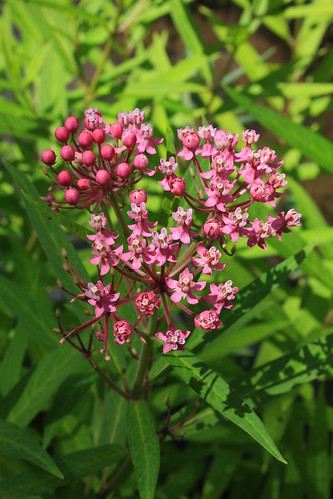
August blooms of Swamp milkweed, Asclepias incarnata.
Along the Chaplin River, KY.
(*photo credit)
August 26, 2014 Remember Women's Equality Day
We need to be reminded that promoting women's rights is not a battle totally won. We hear that American women's incomes are only 70% of male counterparts. Many companies discourage comparing salaries as though a totally private matter. In other parts of the world that inequality, especially in salaried position and elected posts, are being more aggressively tackled than here in America. Certainly the feminine equality agenda is making great strides, but it is a work in progress from the time of suffrage a century ago to a host of employment opportunities today. The road to equality in the Middle East is reaching critical levels as well.
Granted, American women can own property, have an equal voice in civic affairs, practice as physicians and dentists, study along side male engineers, serve in American cabinets and armed services, and become corporate executives. Equality is being fulfilled in the civic arena even though incomplete. In church-related areas, tradition has made a divide among religious denominations on matters of women holding certain offices and functions, with Catholics, Orthodox, Moslems, and more conservative Jews pitted against liberal Protestants and Jews. From early times, Christian groups upheld the traditional male role in ministry along with the social sacraments (Holy Orders and Matrimony), demanding assent of the entire community.
Total assent is not forthcoming at this time on questions of certain ministries within some traditions. Yes, some but not all denominations accept women pastors, priests and bishops. However, diocesan, parish, health, academic and committee administrative positions, even in churches that distinguish between male and female church roles are being filled today by women -- and I address this issue on this website. Is it possible to consider equality different from exact functionality? Are males and females equal, if they can only father or mother another, and not do both functions interchangeably? Having co-equal roles would broaden the cultural debate provided that mothering, nurturing and healing are considered as co-equal to administrative or sacramental roles held by ordained males -- traditional fathering roles.
What seems urgently needed today is to emphasize the unique female contributive roles of initiating the healing process, something that males find difficult to do. Thus, after performing about 200 environmental resource assessments I find women have a unique role in earthhealing as initiators of the process -- a key ingredient to environmental action. This unique healing role cannot be easily initiated by males and thus long-term goals will be completed along side feminine initiators. I am convinced that healing our wounded Earth is a process that is urgently needed today, and women hold a key role that males must recognize. May this observation help advance Women's Equality Day.
Prayer: God, help us see the equal though not necessarily
identical male/female roles in our cooperative endeavors.
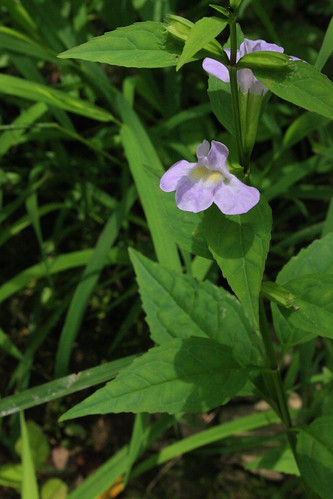
Mimulus alatus, sharpwing monkeyflower.
(*photo credit)
August 27, 2014 Biking Is Healthy but Risky
Bikers take risks, and yet seem willing because the sport gives a true sense of outdoor adventure that is missing while traveling within an enclosed train, plane, bus, or auto. The fresh air and sunshine, the slower travel speed, and the ability to enjoy the scents, sounds, feelings, and colors of the natural world are the bikers' delight. That is why biking is so popular. Furthermore, biking is healthy for the environment; it takes no fossil fuel to move us from place to place except the extra food we eat in getting good exercise; there is no auto pollution or congestion, and bikers are generally happy people.
Bikes and motorized traffic cannot easily compete. I had my near misses in life both when in my youth, when I was missed by a car on a highway. Again, when biking on an unimproved logging road in British Columbia in 1976, I pulled over as close to the shoulder as I could, and the heavy logs went right past my chin. And I would never bike on that stretch today being older, wiser, and less agile on a bike. Neither should others. Many rural and mountain roads are simply not made for fast and heavy traffic and bikes at the same time -- nor built for buggies and walkers who can't compete either. Fifteen years ago our ASPI colleague, Russell Parmes, was killed while riding on a narrow-shouldered U.S.25 highway in our part of Appalachia. In coal-mining and logging regions trucks have enough challenges besides struggling bikers.
In order to be less risky, bikes need to have designated lanes, routes, and pathways, lest accidents be fatal or terribly injurious. If so much resource has gone into the highway network for motorized vehicles, why not a small fraction of federal and state road dollars for bike networks? Bikes need their space and the biker should not be penalized for being so countercultural. Rather, culture needs to catch up to simpler lifestyle alternatives. One good possibility is to use abandoned railroad routes. See Rails-to-Trails (Dec. 29, 08). An emerging trail system for hikers deserves an equal one for bikers as well. More urban areas are giving dedicated lanes for biking, and this hopefully will grow over time -- but urban traffic is risky.
What about bikers who want to travel cross country and spend time seeing our broad and varied nation and world? We should not fault ambitions of such brave souls. They seek an adventure, time off from their work, and time off the beaten path. They deserve encouragement -- but maybe they also need special cautions: plan trips to avoid congested narrow roads; take along compatible companions; pack conservatively and use proper equipment; talk over the possible course with those who have gone before, for they have a wealth of experience worth sharing -- and some good hints. In a similar manner those bikers planning commuter routes in urban areas should follow caution as well, and they might live longer.
Prayer: Lord, give courage and caution to the bikers of the
world, that they may have healthy and less dangerous travels.

Almost-ripe fruit of the heirloom "plumgranny," Cucumis melo.
(*photo credit)
August 28, 2014 Broaden Mother Teresa of Calcutta's Message
The biggest disease today is not leprosy or tuberculosis, but rather the feeling of being unwanted, uncared for, and deserted by everybody. Mother Teresa
This is the 104th birthday of Mother Teresa (1910-2002). In June, 1976 I heard this frail Albanian nun and Indian missionary address a jam-packed gathering at the United Nations Habitat Conference at Vancouver. I had a balcony floor spot with feet dangling over the edge, for all the fixed seats were filled (did we exceed fire capacity rules?). Her message was simple, as were her manner and dress: house the homeless and do so as part of the dignity shown to all human beings, for sub-standard housing is not dignified. Her message was neither preachy nor dramatic, but its simplicity touched our hearts. One does not often hear saints.
Over the years in many ways Mother Teresa and her Missionaries of Charity have touched the hearts of many people of different religious traditions. Somehow there is a message that reaches deeply when someone caresses a dying beggar or a malnourished child. Mother Teresa found the most unwanted and neglected and gave them some special care, and she taught her communities of sisters and brothers to do the same. Through deeds more than words she told us that these poorest of the poor need our help and solidarity. Pope Francis heeds her words and example.
We pray that other generous souls follow in her stead, for the world needs the type of love she was willing to give and places demands on all of us. Our hope extends to more than exemplar models who dedicate their lives to others; all need to change from a consumer culture and share resources with a billion people in desperate need. Mother Teresa did not first ask the suffering people about their religious practice; she instantly loved them for who they were and were willing to become. Her instant love gave to each of these forgotten souls a sense of dignity, and her simple message went out to all, that human abandonment must not continue.
Let's confront the needs that Mother Teresa addressed through a personal and a social activist agenda. Direct service must be coupled with confrontation of a System of billionaires and destitute, for the tolerance of the former can be legitimately addressed without a movement for radical change. It is not an either/or but a both/and. Direct service becomes the world's moral conscience; social justice goes beyond the charitable realms and reaches to structural changes in the socio-economic System. It's more than cheering the huggers of the poor; change involves driving the profiteers out of the commons and here words are verified through deeds. Mother Teresa inspires revolutionaries.
Prayer: Lord, move us to act in meaningful ways especially for those forgotten by the System that overwhelms us. We seek the intercession of Mother Teresa to see the absolute need for service, though this can take on more radical forms of action.

The elegant luna moth, Actias luna, on giant ragweed.
(*photo credit)
August 29, 2014 Whistleblowers Take Risks
Jesus spoke bluntly to the Pharisees and to the world; John the Baptist was a primitive whistleblower by witnessing to the truth, which led to the King's displeasure and cost John his head on a platter. Stephen the first martyr spoke the truth without wincing words and thus receives his award under a heap of hurled stones. Whistleblowing makes public something that others do not want to hear but must be spoken -- and martyrdom often follows.
Whistleblowing is needed in every age and yet it has been rarely practiced, for great risks are involved. In these modern times it may be loss of a job, being driven from a community, and even possibly one's death. Recently in Appalachia a religious leader spoke against local drug lords and he and his family were given short notice to leave the area -- and they did. But speaking out may be Spirit-driven and involves both moral necessary and courage. What about the brave souls who dare teach young girls in Afghanistan, much less young ones who dare to go to school in northeastern Nigeria? These face threats by terrorists. What about soldiers who must interrogate prisoners and refuse to use methods of torture? What about factory workers or researchers who speak against unsafe conditions in Bangladesh? The Earth is full of cases of unreported wrongdoing -- and penalties on reporters.
Caution may be called for. Those tempted to dramatic whistleblowing may have hidden agendas, such as exiting a job they do not like, or exposing a disliked person. We may find it necessary to speak up for the truth on numerous occasions, even when it hurts. We become witnesses to wasteful lifestyles, to helping publicize sincere requests, to entering into the private lives of relatives and friends, and to revealing the small faults of others. Minor witnessing requires preliminary steps of confronting misdeeds through face-to-face encounters, or involving others in such an undertaking. Results could be just as effective without publicly exposing others to shame.
Environmental issues can be occasions of our whistleblowing. The rising threat of climate change, along with a solid core of doctrinaire partisans who are deniers of anthropogenic effects open the way to whistleblowing; ill-treated resources deserve proper monitoring and reporting; polluting companies need exposure; and wasteful practices need addressing. All types of whistleblowing may be lurking out there. Moral righteousness demands public witness to the truth when others (people or Earth herself) are threatened through hidden malpractice. Testimony may be the catalyst to start a process of healing our wounded Earth. Today, we need prophetic voices to call attention to polluting practices that certainly continue to plague our wounded Earth. The role of responsible whistleblowers armed with public petitions may dissipate the risk involved and help hasten the healing process.
Prayer: Lord, give us the courage to be public, the prudence
to act privately, and the wisdom to know when to do either one.

Home-crafting in Kentucky "canelands."
(*photo credit)
August 30, 2014 Enjoy Sorghum-Making
In Appalachia, late summer is sorghum-making season and at this time sorghum makers are preparing for this festive event, something quite distinctive and truly regional in nature. I grew up in traditional American cane, or "river" cane, country. The "canebrakes" were within sight of our home and were originally (in the late 1700s) almost impenetrable thickets of plant growth. This cane grows on fertile soil, and so thickets disappeared when the pioneers converted the brakes into farmland. Furthermore, the species became threatened through overgrazing by livestock that ate the sugary shoots during various non-growing seasons of the year.
However, sorghum or types of sugar cane are not this Native American cane species, but are part of a global source of sugar as a sweetening agent and alcoholic spirits' source of choice. At home, we grew sorghum cane for silage for the cattle, but only later in life did I experience the toil associated with extracting sorghum as an Appalachian culinary delight. This sorghum-making is going out of fashion because it was difficult work, almost "slave labor." That is particularly true of the elementary operation of cutting the cane in the absence of some mechanical cutting implement; the painstaking labor involves using a "corn knife" or machete for cutting each stalk and piling the stalks in an orderly fashion for hauling to the sorghum-making location. Here cane is crushed and sap squeezed. In older times the squeezing was done by a press that was powered by a mule (a long pole device for torque shown in sorghum-making pictures).
The squeezed sap is boiled down to the right consistency by a "master" sorghum maker, who is experienced in turning out good amber-colored sorghum with right color, smell, and taste. The boiling operation requires removing and skimming off any green pulp that would spoil or discolor the final syrup. Boiling requires feeding a wood fire under a long trough or pan, on which the syrup flows as it thickens to proper consistency. The foaming material, "joy foam," that is on top of the cooling syrup is taken up by youth onto cane cuttings and eaten, much like cotton candy at a fair. That is the festive part of "makin' sorghum."
The final effluent syrup is caught at the end of the trough or pan in wide-mouth jars and stored for use later as a sweetening agent. A good grade of sorghum can be stored indefinitely and used for cakes, candies, pancakes toppings, and many cooked dishes. In fact, for earlier Appalachians, this sorghum syrup became the main sweetening agent along with honey. Perhaps what discouraged festivities of community sorghum-making during the last century was the work involved, the expertise needed for making a good syrup, and the low price of crystalline sugar. Many prefer sorghum's own particular flavor for cooking but, owing to care and work involved, it is unfortunately higher priced than other commercial sweeteners.
Prayer: Lord, help us to enjoy good things as from your hand;
help us find festivity in sharing with others good things in life.

Immature Cope's gray tree frog, Hyla chrysoscelis.
(*photo credit)
August 31, 2014 Self-Denial, Sharing, and Growing Vitality
If anyone wants to be a follower of mine, let him renounce himself and take up his cross and follow me. (Matthew 16:24)
Radical sharing with others is at the heart of today's gospel passage. To share means to give up something so that others may have it. This is redistribution and requires a renouncing of what we think we have a right to by inheritance or honest hard work. However, people are not totally taken up with greed and will part with some of this hard-earned money or property for the sake of another who is not as well off. The willingness to be charitable lurks within most of us except the very selfish, and takes on the character of a cross at times.
Is this a question of the limits of prudence and justice? Where does our charity end and our justice begin? Are we moved to get a tax-exemption for sloughed off-unused possessions directed to those in need? The message that Jesus gives in renouncing self is to take the risk of going beyond mere giving a little of our surplus and become radical for the sake of the Lord, as seen in and among the poor. The tax collector Zachaeus was so moved that he became radical in giving, as did many early Christians as recorded in the Acts of the Apostles.
Individually, sharing gives us a lively appearance; it is a gauge of our spiritual vitality. Part of sharing is the shrinking span of time we have left -- and our refusal to allow this to be "mine." We sense the seasons of our life with each birthday and anniversary, when each peer and friend makes the obits, when museums feature tools we used in former decades, when shortness of breath limits our walking course, and when we check that we put our trousers and shoes on. Thus, it takes attention to share the good will that the Lord has given in our limited span of time and to make individual sharing count. We certainly cannot extend the quantity of our days, but we can do the best with what we have left. Don't just count days but make days count.
Socially, radical sharing gives life to communities as well as individuals. We are to be realists and see that sharing gives a greater sense of security to a destitute world, allowing us as a generous people to make real friends throughout the Earth. Far better to assist others to soften the hardness of their lives, rather than to compete with them for the limited, easily accessible resource pie of our Earth. Vitality is part of being realists, and seeing that surplus resources need to be shared among the less fortunate people of the world showering given blessings to giver and receiver. Quality has no spiritual limits to growth, and our improving life of sharing gives all a better future. Happiness is the enjoyment sought for all Americans in our Constitution, and that is worth radically sharing with the poor near and distance.
Prayer: Lord, sustain our vitality so that we can encourage others to live their days and take up their crosses cheerfully. |